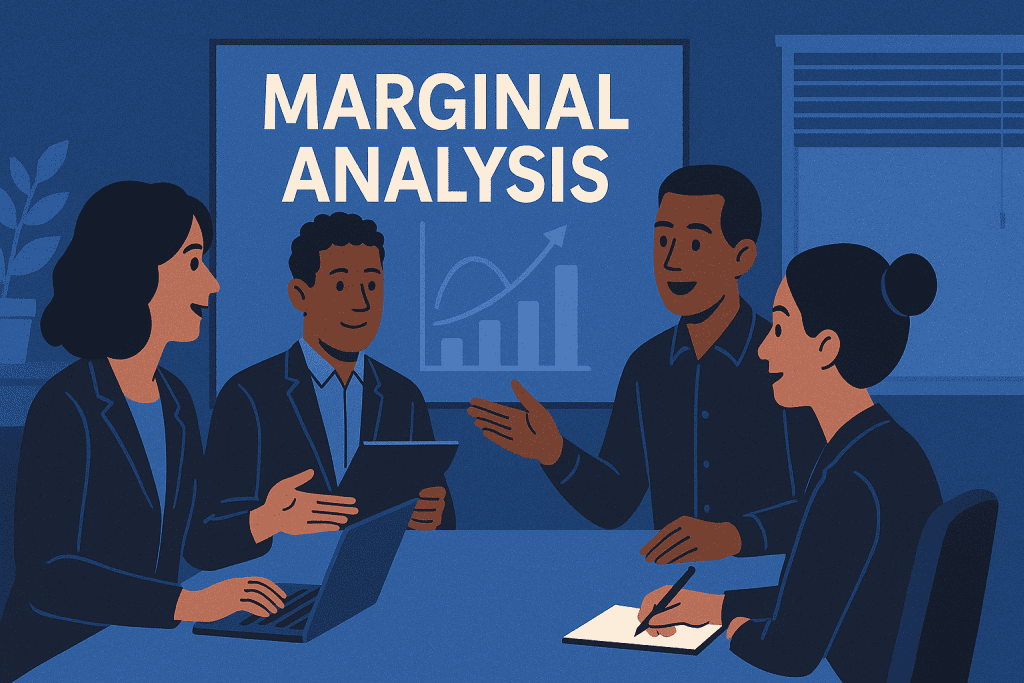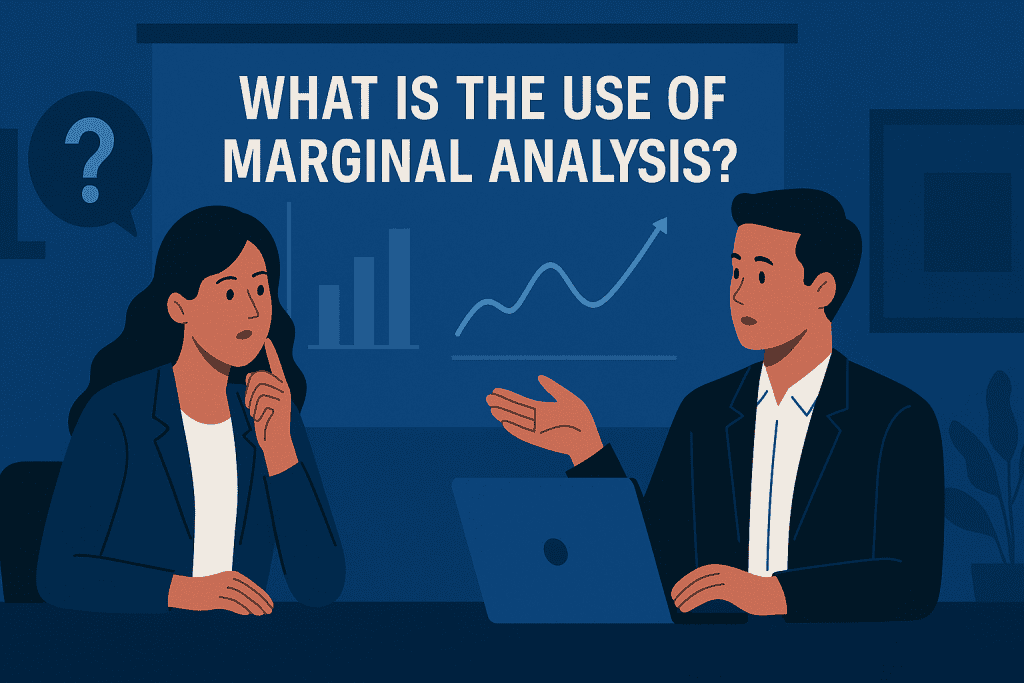Have you ever stood in front of a vending machine, wondering if you should spend another dollar for one more snack? That small decision is actually a classic case of Marginal Analysis in action. In economics and business, Marginal Analysis helps individuals and companies weigh the additional benefit of a choice against the additional cost. It’s a key tool in decision-making, whether you’re managing a household budget or running a billion-dollar corporation.
Understanding how Marginal Analysis works gives you a major edge. It keeps you focused on what really matters: the next best move. In today’s volatile market economy, where every decision can ripple across your finances, mastering Marginal Analysis can help you stay grounded, even during a market crash. It’s not just theory—it’s a real-world decision tool that drives better results.
What is Marginal Analysis

Marginal Analysis is a method used in economics and decision-making to compare the additional benefit of an action with its additional cost. In simple terms, it’s about figuring out if doing “a little bit more” of something is worth it. Whether it’s producing one more unit of a product, spending one more hour on a project, or adding one more dollar to your investment plan, Marginal Analysis helps you make the right call.
Some refer to it as incremental analysis or marginal reasoning. These variations all center around the same idea: analyzing the cost vs. benefit of the next unit of action. It’s a way of thinking that makes decisions sharper, leaner, and more efficient.
Breaking Down
Marginal Analysis breaks every decision into two parts: marginal cost and marginal benefit.
Marginal cost is the extra cost of producing or consuming one more unit. That could be a cost in time, money, effort, or any other resource.
Marginal benefit is the added value or satisfaction you get from that extra unit.
Here’s the rule: if the marginal benefit is greater than the marginal cost, it’s a smart move. If not, it’s better to stop.
Let’s say you’re running a small bakery. You already bake 100 cupcakes a day. You consider baking 101. The marginal cost might be the price of extra ingredients and an additional 10 minutes of labor. If the marginal benefit—say, from selling that cupcake—is higher than those costs, then it’s worth it. If not, you skip it.
This applies far beyond bakeries. Investors use Marginal Analysis when choosing between Best stocks to buy. Marketers use it to decide if spending more on ads is worth the extra reach. Even families use it when deciding whether to upgrade a car or go on vacation.
A big advantage of this method is that it keeps decisions focused and flexible. Instead of thinking in extremes—buying all or nothing—you evaluate one step at a time. This reduces risk, especially in unpredictable environments like today’s Economic System.
Marginal Analysis is also key in managing scarce resources. In fields like health care, education, and energy, where resources are limited, deciding how to use “just one more” can mean the difference between success and failure.
Whether you’re applying it to business expansion, product development, or personal trading strategies, this simple yet powerful approach helps keep your choices rational and results-focused.
History of Marginal Analysis
Marginal Analysis originated during the late 19th century as part of the marginal revolution in economics. Economists like William Stanley Jevons, Carl Menger, and Léon Walras introduced the concept to explain how individuals make decisions at the margin, rather than in total.
| 1870s | Marginal revolution begins |
| 1890s | Concept becomes central in microeconomic theory |
| 20th century | Expanded into business strategy and behavioral economics |
| Present | Widely applied in economics, finance, marketing, and policy-making |
Types of Marginal Analysis
There are several variations of Marginal Analysis, each tailored to specific scenarios. Let’s break them down.
Marginal Cost Analysis
Focuses on the added cost of producing or doing one more unit of something.
Marginal Benefit Analysis
Looks at the extra gain or satisfaction from consuming or producing one more unit.
Marginal Utility Analysis
Common in consumer theory, it evaluates the change in satisfaction as consumption increases.
Marginal Revenue Analysis
Used in business to assess the additional income from selling one more unit of a product or service.
Marginal Productivity Analysis
Evaluates the change in output resulting from one more unit of input (like labor or capital).
| Type | Purpose |
|---|---|
| Marginal Cost | Measures added expense |
| Marginal Benefit | Measures added gain |
| Marginal Utility | Tracks satisfaction shifts |
| Marginal Revenue | Analyzes sales impact |
| Marginal Productivity | Assesses efficiency |
How Does Marginal Analysis Work?
Marginal Analysis works by comparing what you gain vs. what you give up. The key is to isolate the change—the “marginal” part—and measure it clearly. Businesses use spreadsheets and models to calculate marginal revenue and cost. Individuals use simple logic: is the next hour of work worth the money? Is that extra scoop of ice cream worth the stomach ache? It’s all about trade-offs, done thoughtfully.
Pros & Cons
Before using Marginal Analysis, it helps to weigh its benefits and downsides:
| Pros | Cons |
|---|---|
| Encourages logical decision-making | Can overlook emotional or ethical factors |
| Optimizes resource use | Requires accurate data |
| Prevents overproduction | Can be too focused on short-term results |
| Useful across many industries | Not always intuitive |
Uses of Marginal Analysis

Marginal Analysis is a practical, real-world tool used to improve decision-making across various industries. It helps businesses, governments, and individuals assess whether the benefit of doing something just one more time is worth the cost. This isn’t just theory—it’s the backbone of smart choices in dynamic, high-stakes environments.
Finance and Investing
In finance, Marginal Analysis is essential for evaluating whether adding more funds to an investment plan makes sense. For example, investors might use it to determine if purchasing an additional share offers enough return to justify the risk—especially important during a market crash when risk tolerance shifts. It’s also used to identify the Best stocks to buy, focusing on marginal gains instead of broad speculation.
Business Operations
Businesses apply Marginal Analysis to streamline production and reduce waste. A company might analyze whether producing one more unit of a product increases profit or drains resources. This small-scale thinking prevents overproduction and helps maintain efficiency, especially in competitive markets.
Marketing and Sales
In marketing, Marginal Analysis informs budget allocation. Teams evaluate if spending more on ads or campaigns will drive enough extra revenue. Sales departments use it to assess whether adding a new salesperson or targeting an extra lead segment will result in measurable growth.
Economics and Public Policy
Policymakers use Marginal Analysis to allocate limited resources wisely. Whether choosing between building new infrastructure or funding healthcare, governments apply marginal thinking to ensure each dollar spent delivers the highest return, especially in strained Economic Systems.
Accounting and Strategy
Accountants and business analysts use Marginal Analysis for pricing and cost control. It helps evaluate product profitability and guides trading strategies, ensuring decisions are based on data—not guesswork.
Resources
- Investopedia. What Is Marginal Analysis?
- Corporate Finance Institute. Marginal Analysis
- Salesforce. Marginal Analysis in Revenue Lifecycle Management
- Principles of Economics. Economic Concepts – Marginal Analysis
- Accounting Insights. What Is Marginal Analysis: Definition + Examples
